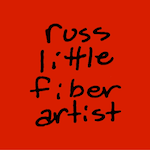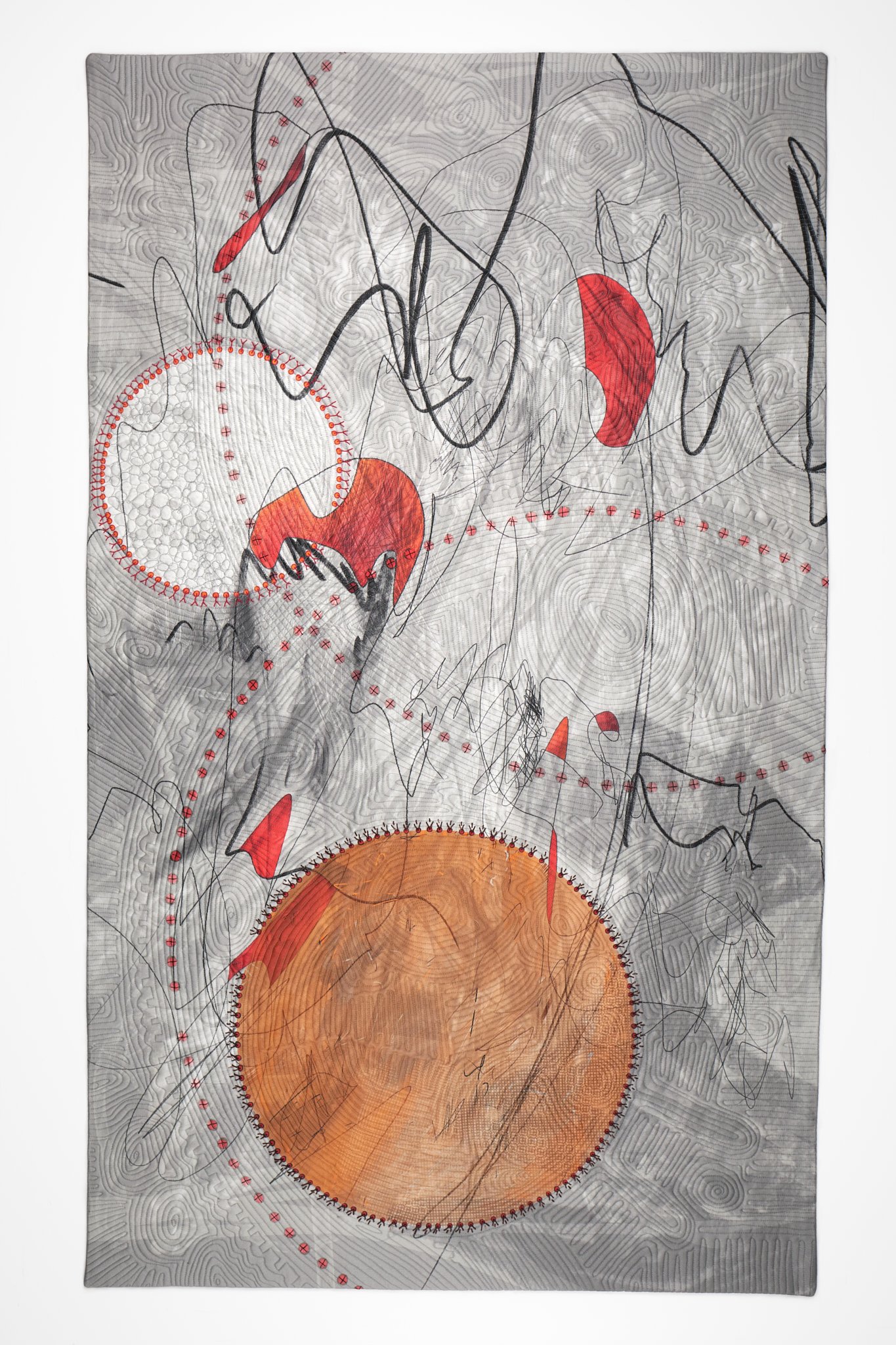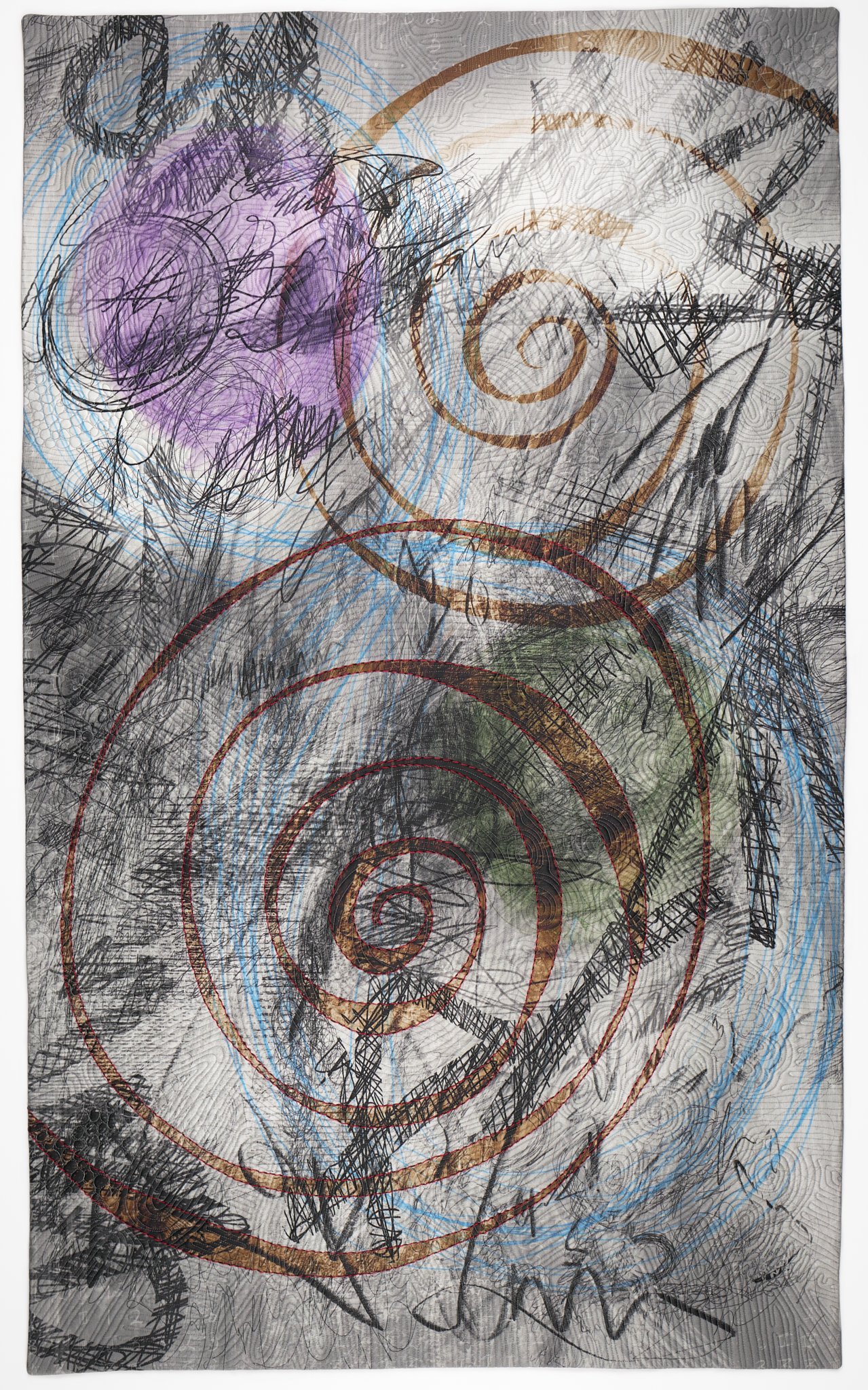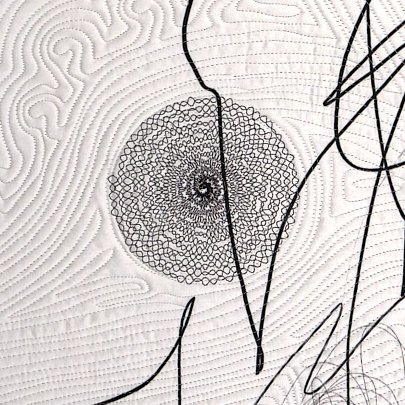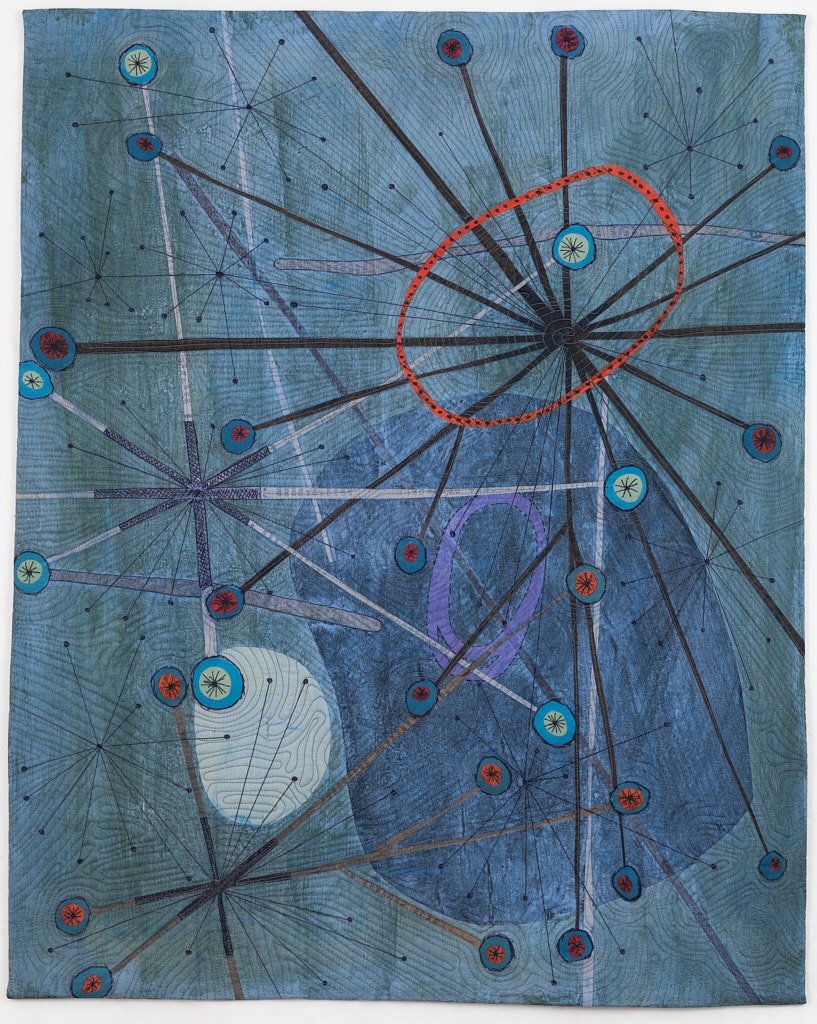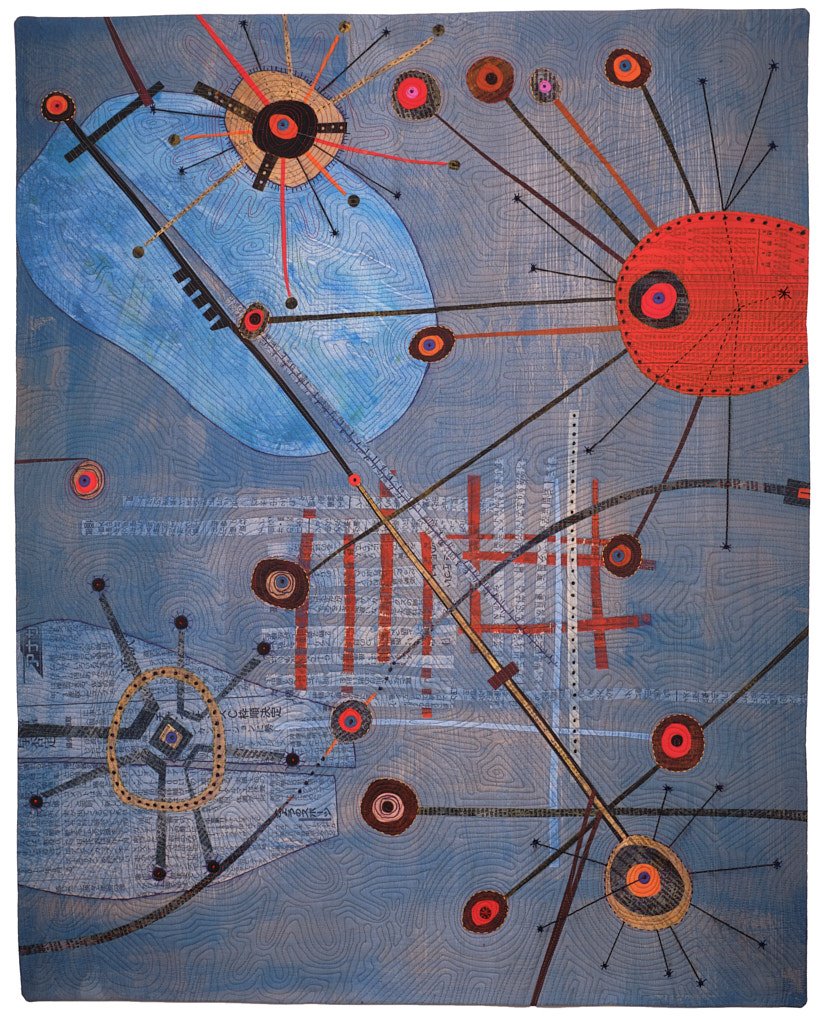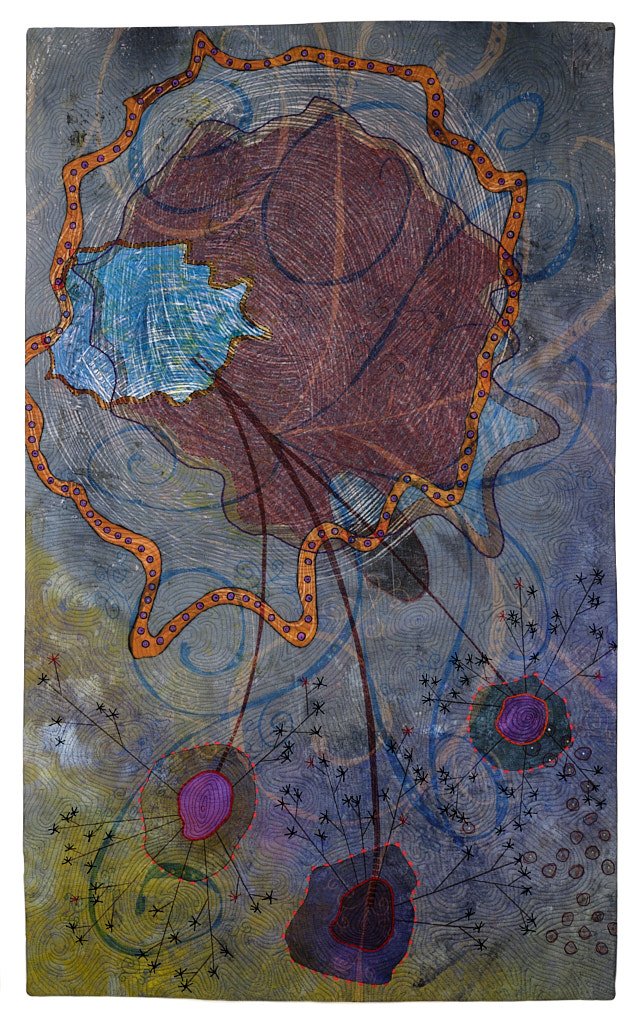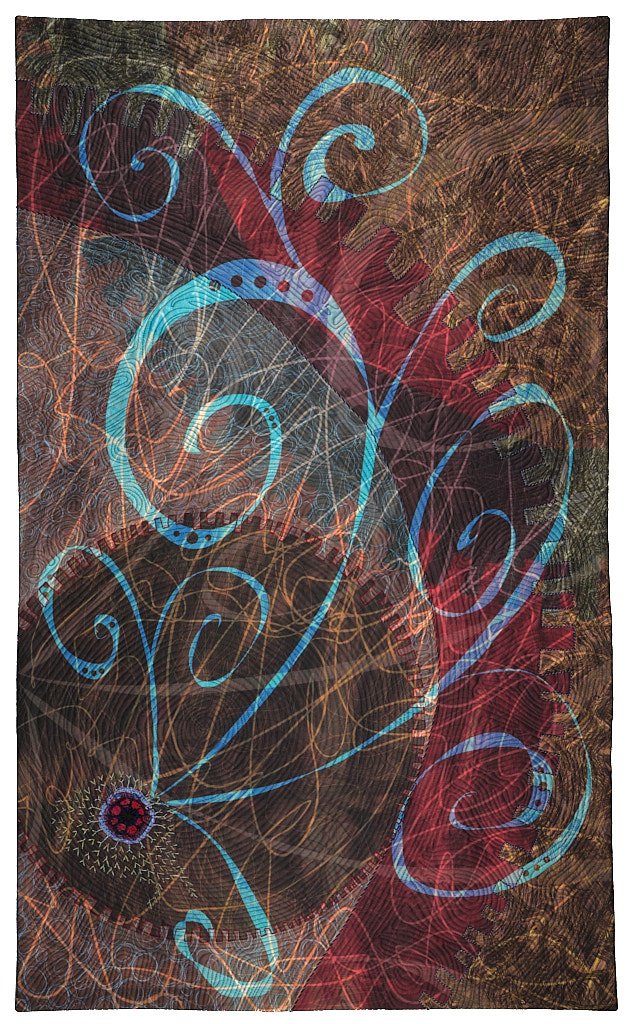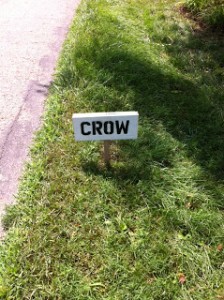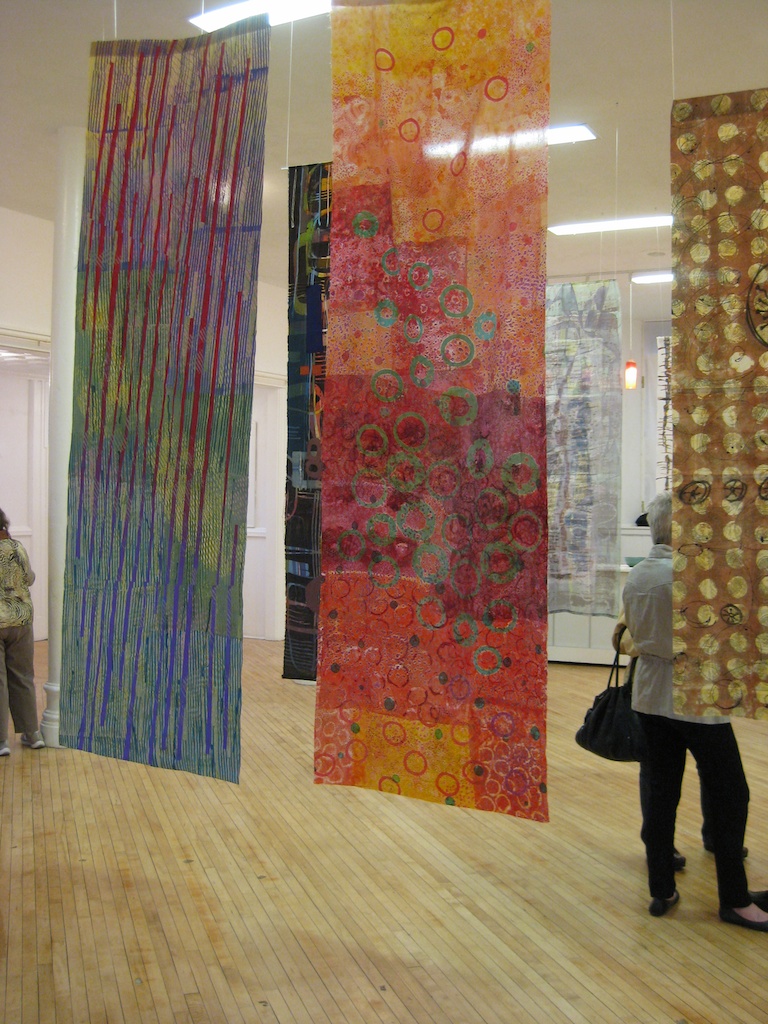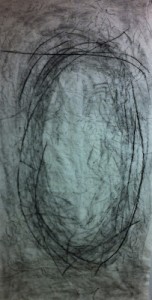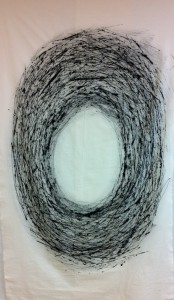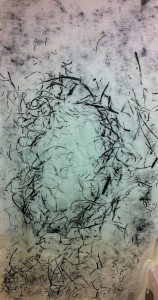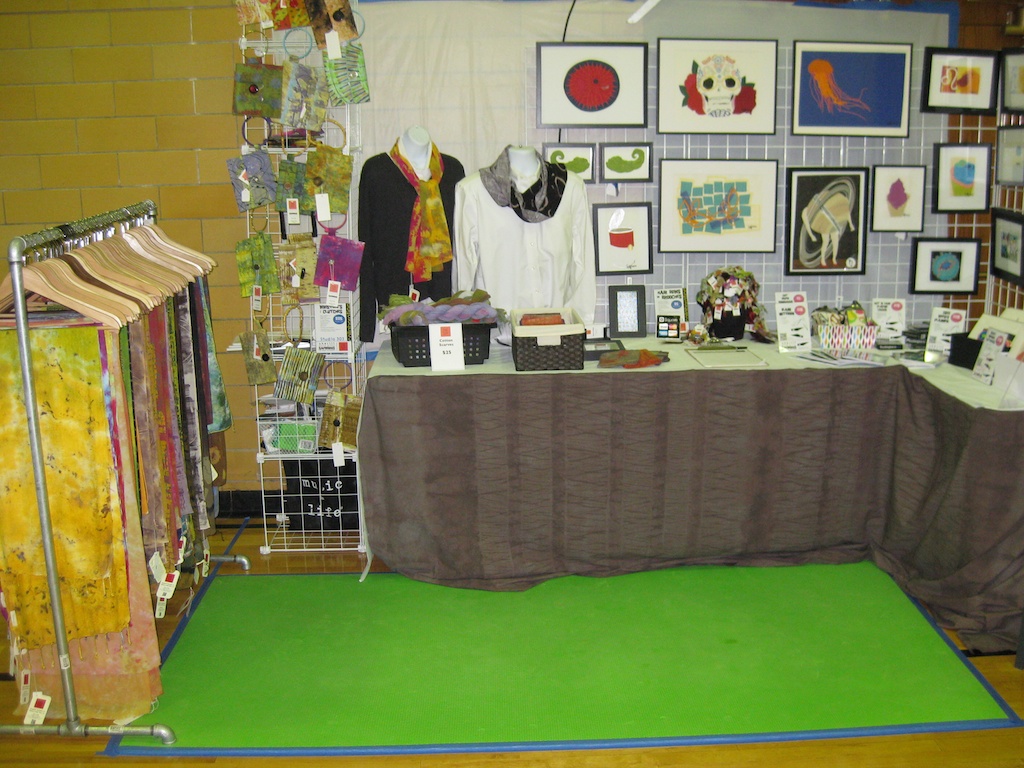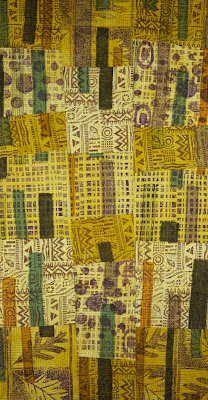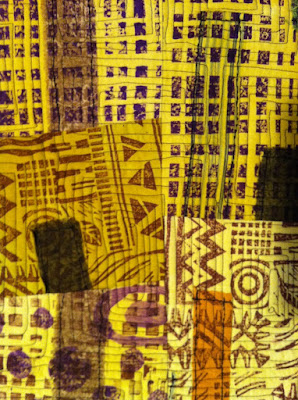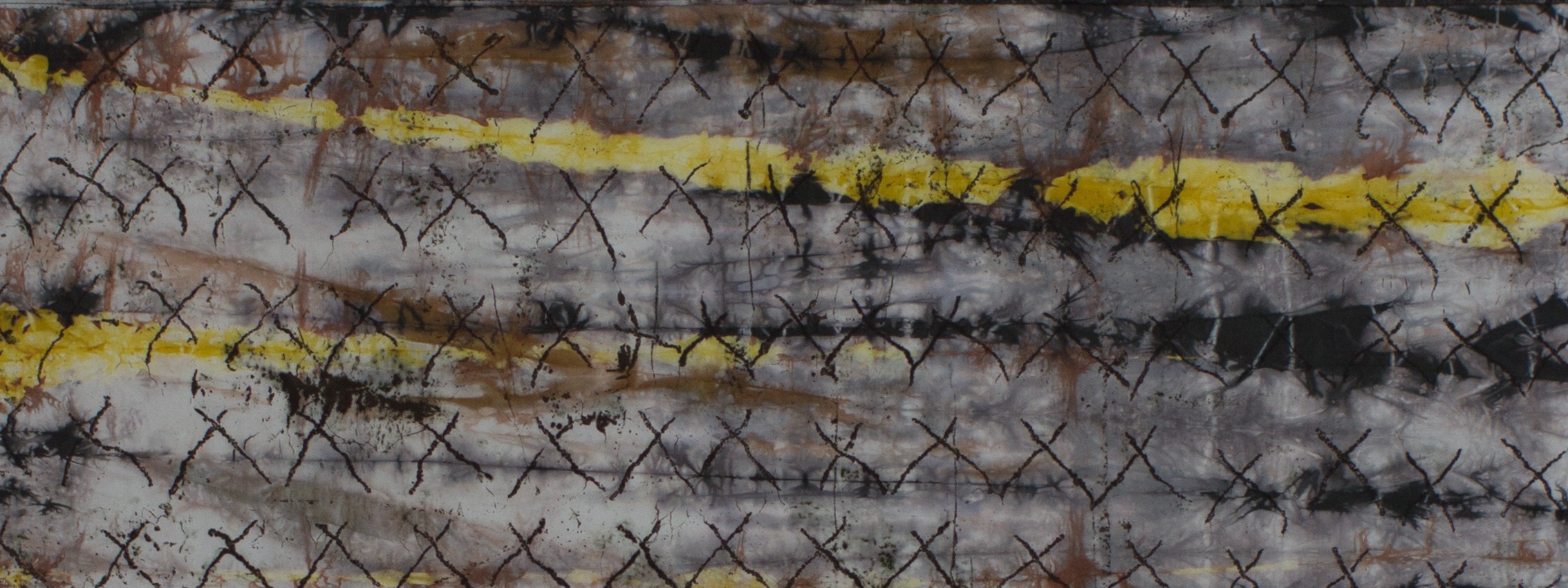
Thoughts & news
Thoughts about the Mindful Scribbling series
Mindful Scribbling #1. 2022
I’ve written before in numerous places about the advantages of creating artwork in a series: developing ideas, refining technique, seeing how thoughts evolve over time to name a few. Artwork, and series work in particular, can also be a way of processing experiences and emotions in a way that writing, talk therapy, and other verbal exercises might not. The Mindful Scribbling series is an example of all of these things.
I think that artwork should stand on its own without copious explanation of what it’s about. It’s either compositionally strong and engaging or it’s not. Explanation can enhance understanding, but shouldn’t be the reason for deeming a piece to be outstanding. I think that the work in this series is strong in its own right, but it also merits a deeper discussion of the backstory, at least in this particular case. So, here goes.
The backstory
At the time of this writing I believe that it’s safe to say that the reader recalls, from their own lived experience, the spring of 2020. People in the US and many other countries were living in government mandated isolation in their homes, hoping to arrest the spread of COVID-19, all the while watching terrifying reports of overrun hospitals and morgues on TV. “Lockdown,” as it came to be known, seemed to help and hurt in equal measure. Children, older folks, and people living alone suffered from social isolation. It was even a bit much for introverts like myself. Patients in hospitals were separated from their family members in an attempt to protect both medical staff and patients from visitors who might be carrying the virus. This exact scenario was one of my worst fears—that I or my husband would be hospitalized, separated, and unable to help each other. That’s just what happened, but not in the way that I feared.
TRIGGER WARNING: The following paragraph deals with a car crash and the ensuing hospitalization. If those are things you’d rather not read about then skip the section within the red horizontal lines.
On June 2, 2020 my husband, Dan, was on his way to play a round of golf—a safe, masked, socially distanced, outdoor activity. Along the way his car was struck broadside by another car. Dan’s car was the third car entering an intersection after the light turned green. The driver of the other car ran the opposing red light at 95 MPH. Dan lived, but only barely, He was cut out of the car, intubated at the scene because he wasn’t breathing but somehow did have a pulse, and taken to a level-one trauma center. He had a closed head traumatic brain injury, broken bones (ribs, vertebrae, shoulder, sternum, and knee), collapsed lungs, cardiac trauma, and he was on a ventilator. I learned all of this over the phone because I wasn’t allowed to enter the hospital, much less visit him. His first ICU doctor arranged for me to visit, with the expectation that I was most likely coming to say goodbye. I don’t know why or how she managed this, but I came to understand that it was way outside the norm. It was a horrible experience but one for which I will always be grateful. Dan came home on 10 weeks later on Aug 12 after several trips to the OR, 3 weeks in ICU, time in a “skilled” nursing facility, and almost a month at National Rehabilitation Hospital (Medstar NRH). With the exception of the almost-deathbed visit and a surprise encounter in July when I happened to see him being loaded into a medical transport van on the way to NRH, we were completely separated. He remembers nothing of the entire month of June and July is a bit fuzzy, which says a lot about the nature of brain injuries. I remember everything. By mid-July he had recovered enough to manage phone calls and FaceTime. He spent a year in outpatient PT and OT, with speech/language therapy and vision therapy and another surgery thrown in. It was our whole lives. Obviously we wish it never happened, but we owe everything to the doctors, therapists, friends, family, and colleagues who helped put Dan’s body and our lives back together. “Back together” doesn’t mean “the same as it was.” He can walk, talk, see, think and care for himself—things I was told were possible, but not guaranteed. He went back to work and is as smart and capable as the sharpest person in most rooms. Neither of us takes these things for granted.
If you can believe it, that’s the short version of what I did during COVID isolation. There was no art-making. I’m a self-employed, full time artist, and my income isn’t the one keeping our household running. That meant that I could walk away from the studio and give everything to managing Dan’s care and the frightening and confusing bureaucratic mess we’d landed in. There were calls to insurance adjusters, our lawyer (to deal with the insurance), doctors, therapists, and the assistant state’s attorney and the investigating officer (to deal with the prosecution of the guy driving the car that hit Dan). There was communication to manage—family, friends, and colleagues across three continents. And, as I said, there was no art-making.
Returning to the studio
I did try to draw a little while Dan was away. I picked up my iPad and the most that I was able to manage was a series of angry scribbles in black and white. I’m grateful for the moment of clarity when I said to myself, “Don’t do this now. It’s not the time. You’ll find your way back, but not today and not for a while.” So, I focussed on the big problems and left the studio—literally and figuratively—to collect dust.
When I did get back to work, late in the winter after the accident, we were still dealing with a full therapy schedule (3-5 days per week). I did things like clean out the studio storage closet and organize shelves. That activity prompted the ongoing Reformation series, which you can read about on the Reformation Overview page. Eventually I looked at those scribbles and began to wonder what would happen if I spent a little time with them. I didn’t intend it as any sort of art therapy, but I saw something spontaneous and interesting in the marks that seemed to warrant further consideration. Over time those scribbled drawings evolved to become the Mindful Scribblings series, a group of six quilted paintings that I never intended to make, but which happened none the less.
Some general observations
Size and materials
All of the pieces in this series measure 31 inches wide by 52 inches tall. They are whole cloth paintings created on an iPad using Procreate. The finished compositions were printed on cotton sateen by Spoonflower (spoonflower.com). Each was layered with acrylic felt batting and a muslin backing, then free motion quilted. Numbers 1, 3, 4 and 5 include hand embroidered details that I added prior to quilting. Numbers 1 and 2 includes 12 machine embroidered motifs in total. I designed all of these elements using either drawing software or programs that I wrote myself. All of the resulting designs were then stitched out using an embroidery attachment on my sewing machine.
Change over time
There are six pieces in the Mindful Scribblings series. Similar to the pieces in the Outward Movement series, the pieces are numbered in chronological order and I can see change over time. The earliest pieces, #1 in particular, are largely monochromatic or have a very limited palette, while the later ones are more colorful and lively. They all have a doodle quality, which becomes more complicated as you move though the series.
The final piece, #6 is definitely part of the series. It has the same scribbling quality and, while the palette is broader than the early pieces, it is still limited. The spiral forms speak to the doodle quality of the other pieces and to the circular forms seen in all of the pieces, except possibly #4—though I would argue that the three colored shapes along the midline of #4 could be interpreted as imperfect circles. Two things that are particularly interesting about #6 are that it references motifs found in some of my other work (circular and spiral shapes, and large shapes that dominate the canvas, as compared to the smaller, tighter shapes in the other pieces in the series). I interpret this as an indication that I was beginning to reconnect with my pre-crash body of work, and that’s why I feel that #6 brought this series to a close.
The nature of doodles
Whether it’s doodling in the margins of a notebook during a meeting or intentionally playing with doodles in a sketchpad, these unplanned marks can be revealing. In some cases they might speak to one’s state of mind at the time they’re drawn. In others they might open the way to discovering new marks, glyphs, or motifs, which could be incorporated into future designs.
There are certainly things that I draw when my pen is aimlessly occupying itself on a page: counting-style hash marks (e.g., 4 vertical lines and an overlapping diagonal line to represent 5) grids, isometric cubes, meandering lines with filled shapes, and more. I don’t really know if any of these things mean anything, though I will confess that when I’m stressed I often find that I count (silently, to myself), so perhaps the hash marks are an extension of that. I’m less concerned about the meaning and more about graphic quality of these marks and the feeling that they carry an authenticity. They aren’t something that I invented for the purpose of including them in a design. (In a couple of paragraphs I’m going to say something that contradicts that statement, but stay with me for now.)
So, the doodles showed up to some extend in the original drawings. For this series I had those drawings printed on cloth by spoonflower.com then added elements to the design through hand and machine embroidery before quilting. The hand embroidery is generally intended to reinforce existing forms in the composition. However, in the case of #3, new circular shapes were introduced. Hand stitching is show, laborious, something a little painful (hand cramps and sore fingers), but also meditative.
Machine Embroidery
My doodling takes another form as well. I’m not sure what to call it except possibly code doodling. I’ve been doing some form of computer programming since the last 70s. You might say that its a left brain logical activity that balances out my right brain creativity, or perhaps its another expression of the right brain stuff. Either way, it’s something that I enjoy doing. Sometimes I get an idea and think, “Hmm, I could do that by hand, but wouldn’t it be interesting to do it with a computer and try loads of different variations.” Those code doodles have often made their way into my artwork as graphic elements in a design that’s printed on cloth (again, by spoonflower.com). In recent years I’ve figured out how to turn iPad drawings and mathematically-derived patterns/shapes into files that will drive the embroidery module on my sewing machine.
The collection of detail images below shows some of these machine-embroidered elements found in #1 and #2. While this isn’t meditative in th way that hand stitching is, there is still a mindfulness involved in the entire process.
Quilting lines
I’ve always said that I look at quilting as the last layer of drawing added to a quilted composition. In the case of this series the quilting lines, while still entirely improvisational, are very much intended to both reinforce and extend the design elements. As seen in the detail image below, the circular quilted elements in the open white background of #1 are a good illustration of this idea of compositional elements represented solely by quilting lines. Other quilting lines reinforce lines of flow or help provide definition for other quilted elements. For example, the straight lines in the upper right corner help give definition to the large quilted circle and create an, albeit subtle, figure-ground distinction.
Mindful Scribbling #1, detail
Things we’re afraid to say out loud
I haven’t addressed the embroidered block of odd patterns in #2. That deserves attention, if only to save the explanation here for posterity. But, I’ve intentionally saved it for near the end.
There are things that we say to each other—superficial greetings or observations about the weather. There are deeper things too. There’s also that old rule about not talking about sex, religion, and politics in “mixed company,” at the dinner table, and so on. Personally, I think those are some of the most interesting conversations. But—there are some things that we might want to say but feel hesitant to say them at more than a whisper. Those might be things like, “Mom, I’m gay,” or “I love you”, or “I’m disappointed in you right now,” or “I’m scared.”
For years I’ve been fascinated by the way that encryption and obfuscation can be used to speak a secret and keep it hidden at the same time. That’s what those pattern in #2 are: graphically encrypted text. I wrote a Python program to run text through a complex substitution cipher, converting the letters into numbers and representing those numbers with as symbols. The results get written to a file that’s compatible with the embroidery module on my sewing machine. I won’t bother you with the logic of the encryption, but I will come clean on what the blocks of text say.
On June 2, 2020, against all odds, he became The Boy Who Lived.
Forever altered, we both survived.
Is life just a never-ending cycle of trying to stand, getting knocked down, and getting back up again?"
So, now what?
Do we just wait?
How do I stop holding my breath?
Final thoughts
This spring (June 2024) will mark 4 years since Dan’s car accident. The Mindful Scribbling series—the one that I never intended to make—has come to a natural conclusion. There are no new series that directly address the experiences of 2020-2021. I’ve written about all of that and, while Dan, our friends, our family, and I will never forget those events, I don’t think that the story needs more telling or that more art needs to flow from those experiences. Having said that, it’s worth noting that everything we are and do stands on the foundation of all of our prior living and learning. It will always be there in some way; to deny it would be foolish, but to be trapped in those memories would be wasteful.
Timeline and history
| Title | Date | History |
|---|---|---|
| Mindful Scribbling #1 | 2022 |
Juried into "Quilt National 2023" Published in "Quilt National 2023" exhibition catalog Exhibition: "Quilt National 2023," Dairy Barn Art Center, Athens, OH, May 26 - Sept 11, 2023 Exhibition: "Quilt National 2023," Holter Museum of Art, Helena, MT, Oct 26, 2023 - Jan 1, 2024 |
| Mindful Scribbling #2 | 2022 |
Juried into "Quilts=Art=Quilts 2022" Exhibition: "Quilts=Art-Quilts 2022," Schweinfurth Art Center, Auburn, NY, Oct 29, 2022 - Jan 8, 2023 |
| Mindful Scribbling #3 | 2023 | |
| Mindful Scribbling #4 | 2022 |
Exhibition: "Between the Lines, (Gayle Friedman & Russ Little)," Portico Gallery, Brentwood, MD Nov 19, 2022 - Jan 14, 2023 |
| Mindful Scribbling #5 | 2023 | |
| Mindful Scribbling #6 | 2023 |
Thoughts about the Outward Movement series
Outward Movement #1. 2018
Most of my artwork is created in a group or series of pieces that are related by content, purpose, or method. Working this way allows me to explore an idea over time and to refine my thinking. That isn’t to say that the earlier works in a series are somehow less than the later works, but looking at the group as a whole often reveals an evolution of thought. Sometimes I don’t even see that pattern of change myself until I’m well into the series or until I sit down to think and write critically about what I’m doing—like now.
I’m grateful to have completed several series, and to have several more still ongoing. The “completion” of a series is less a matter of reaching a predetermined goal of a number of pieces and much more about intuitively knowing that I have reached a point of completion. When the thought is complete, the mental itch has been adequately scratched, or I feel that the next piece is going to be forced simply for the sake of making “just one more” then it’s time to move on. I’ve recently decided that Outward Movement is finished, so this is a good time to capture my thoughts about this body of work. I’m hoping to do the same for my other completed series in the future.
Two subgroups
The seven pieces in the Outward Movement series were completed between 2018 and 2022. There are two distinct groups within the series:
The earlier, smaller pieces (1-3) measuring about 26 x 33 inches and the later pieces (4-7) measuring about 31 x 52 inches.
The first group all began their compositional lives as painting with collage elements on hardboard, while the second group are entirely digital compositions created on an iPad.
Why and how size might matter
Why the size change in the middle of the series? Gosh there are so many bad jokes to be made here about comparing size, but it really came down to a conversation that I had with a juror at an opening reception. She said something like, “I really like your piece, but it needs to be larger. It needs a ‘gallery presence’ that draws people to it from across the room.” Textile works of this sort— so called art quilts—tend to be large pieces. We’re talking in the range of 80 x 80 inches. That’s big, hard to store, difficult to ship, and when it comes to pricing they’re also much more expensive than smaller work. Also, show of hands, who has an empty wall in their house that doesn’t get direct sunlight, and can accommodate something that size? And yet, looking around that gallery I could see her point: my artwork looked out of scale, dwarfed by more monumental work. And thus, the size of 4-7 is both wider and taller but still within a size that could fit into someone’s home. I’ve now seen these larger-sized works in similar settings to that first show and I think that, while not being monumental themselves, they hold their place in the room better. Having said all of that I will observe that 1-3, the smaller pieces, have all been sold. So, do I size my artwork for the home or the gallery? It’s an open question, the answer to which I think might be to make some of each.
The ways I work
The first group is also different from the other in that these three pieces represent a combination of computer and manual techniques, and they all have a strong visual look that captures the hand drawing and painting, as seen below. I created 16 x 20 inch painted backgrounds on hardboard. On top of these I added painted paper shapes and lines and hand drawn elements to create the final composition, and these paintings exist as artworks undo themselves. Each finished painting was photographed, then the images were color corrected and printed on cloth using a wide carriage inkjet printer (by spoonflower.com). The printed fabric was stacked with acrylic felt batting and muslin backing then machine quilted.
Outward Movement #2
Outward Movement #3
Numbers 4 through 7 were created as paintings on an iPad using the Procreate app, which allows me to create layered drawings with shapes, fills, and a wide variety of line and brush marks using a stylus. These were among my first digital compositions. Number 4 is an all digital composition, but the highly textural background is derived from a photograph of a gelli plate monotype print with additional relief printed elements. With Procreate I was able to manipulate the image and add line and shape elements. By contrast, #7 is entirely digital. All of the background and foreground elements are created entirely in Procreate.
Outward Movement #4
Outward Movement #7
Hand stitching
Many of my pieces include some element of stitch beyond the obvious quilting lines. Sometimes the added stitch is created using an embroidery machine and other times by hand. In all cases the intent is to add detail and emphasize elements. On another more subtle level I also intend it to play off of, and contrast with, the regularity and sharpness that can come from computer-printing. The printer creates a far sharper line than I would by hand; the subtle or not-so-subtle irregularity of hand stitching can soften that sharpness.
Hand stitched details on Outward Movement #7
Quilting lines
For many years I’ve said that quilting lines are the final drawing element that I add to a quilted textile composition; it continues to be true. I quilt on a sit down long arm quilting machine. That means that the machine remains stationary while I move the quilt around freely under the needle. There are no feed dogs to move or guide the fabric. The quilting patterns are spontaneous. The only planning that goes into what I quilt is when I periodically stop, put the quilt on the design wall, and think about what might come next. There’s never any marking, templates, or rulers. The image below is a good example of much of my quilting. The quilting lines are reactions to the graphic elements, following the lines of the composition, but they also create new shapes that echo, emphasize, or stand in juxtaposition to the graphic elements and each other. The quilting lines are also an exercise in drawing with shadow. When the finished artwork is hung on a wall and lit from above, the texture created by the quilting catches the light, casting tiny shadows and bringing the surface to life.
Hand stitching and machine quilting lines on Outward Movement #6
Symbols and meaning
Circles
When I look at all 7 pieces in the series it is undeniable that circular forms are a key element. We all have shapes that speak to us. From some folks it’s squares; for others triangles. For me it’s circles, and they find their way in to most of my work in varying sizes.
The circle symbolizes a completed cycle, a center, wholeness, softness, enclosure,—perhaps even an embrace or protection.
Lines and paths
Lines can do several things in a composition: divide space, demarcate shapes, create connections, and establish flow. It’s impossible not to notice that the earlier pieces in the series emphasized straight lines, while the later pieces use many more curved lines. The curved lines more your eye through the piece differently than the straight lines. They also give the later pieces a more organic feel. The curling and branching lines feel vine-like, but also playful. Drawing these element felt like a playful act, and I think that feeling is instilled in the result.
Juxtaposition of angles and curves
Angular lines and sinuous lines are interesting on there own. Straight lines and sharp angles can evoke a feeling of the built environment, while curved one might feel more organic. Incorporating both angular and curving lines into the same composition can be an interesting way to depict the interaction between these two things—the built world and the natural. This is a recurring theme in my artwork and a design motif I use often.
Relative scale
Looking at the series in chronological order, I find it interesting that the circular elements become fewer and grow larger. In #7, about one third of the large gear-like circle covers most of the design space. I see this shift in scale as an opening up of the circle. As the circles get larger they begin to move more and more out of the design space. This feels like a natural expansion, like opening my arms from a tightly crossed posture. This expansion and outward movement wasn’t planned, and was only apparent to me after the later pieces were finished. And so, having grown the design elements right off the page, it feels that I’ve arrived at a fitting end point for the series.
Portfolio links
Timeline and history
| Title | Date | History |
|---|---|---|
| Outward movement #1 | 2018 |
Quilt National 2019, Dairy Barn Art Center, Athens, OH, May 25 – Sept 2, 2019 Quilt National 2019, Foundry Art Center, Saint Charles, MO, Oct 4 - Dec 6, 2019 Published in Quilt Naitonal 2019: The Best of Contemporary Quilts Sold in 2019 |
| Outward Movement #2 | 2019 |
Quilts=Art=Quilts 2019 Sold in 2019 |
| Outward Movement #3 | 2019 | Sold in 2021 |
| Outward Movement #4 | 2020 | Between the Lines, (Gayle Friedman & Russ Little) Portico Gallery, Brentwood, MD Nov 19, 2022 - Jan 14, 2023 |
| Outward Movement #5 | 2020 |
Published in Wide Open: An Exhibition by the Art Cloth Network Open Space, Cultural Activities Center, Temple, Texas, Nov - Dec, 2021 (a combined showing of ACN The Space Between and Wide Open) Open Space, Austin Bergstrom International Airport, Austin Texas, Zilker and Jollyville Galleries January - May, 2022 (a combined showing of ACN The Space Between and Wide Open) Between the Lines, (Gayle Friedman & Russ Little) Portico Gallery, Brentwood, MD Nov 19, 2022 - Jan 14, 2023 Wide Open, Bloomingdale Parks District Museum, Bloomingdale, IL June 8 - Aug 5, 2023 |
| Outward Movement #6 | 2020 |
Between the Lines, (Gayle Friedman & Russ Little) Portico Gallery, Brentwood, MD Nov 19, 2022 - Jan 14, 2023 |
| Outward Movement #7 | 2022 |
Between the Lines, (Gayle Friedman & Russ Little) Portico Gallery, Brentwood, MD Nov 19, 2022 - Jan 14, 2023 |
Art Quilt Elements 2020 virtual opening reception and artist talk
Art Quilt Elements 2020, one of North America's premier juried art quilt exhibitions, was originally scheduled to hang at the Wayne Art Center outside of Philadelphia in March 2020. And then came Covid-19.
AQE 2020 will now open virtually this May 14th with an online gallery and live virtual artist reception. This event will also include the release of the 2020 print catalog and the debut of the AQE 2020 video.
I'll be speaking briefly about my piece "Beautiful Chaos #1" during the meet-the-artists portion.
The Zoom opening event is free, but does require pre-registration Visit https://www.wayneart.org/exhibitions/aqe-2020-online-exhibition-live-event/ to signup and get login info.
Wonderful art cloth exhibit in Miami
Photo: Daniel Portnoy
This has been a confounding year so far. After a couple of surgeries (3 in 9 months), I feel like I've addressed some deferred maintenance issues, which is good. But, it seems that every time I've sort of gotten my feet back under me I've fallen over again--metaphorically speaking. As a consequence, the studio as been a disjointed, unproductive, unfulfilling confusing, mess--but things are turning around a looking up. I have 5 art quilts nearing completion, and I feel like I'll be strong enough in a few weeks to safely lift dye buckets.
Meanwhile, wonderful things have been happening for the Art Cloth Network. Our exhibit team has landed some outstanding venues this year, the most recent of which is the terminal gallery at Miami International Airport. The gallery is part of Miami-Dade County Division of Arts & Cultural Affairs, and they've been fantastic to work with. They even produced a stunning color brochure to accompany the show. The show is in a gallery that's inside the security perimeter, but if your travels happen to take you through MIA, check out the "Material View" exhibit.
That's my piece hanging at the entrance to the show--BIG SMILE. (Photo: Daniel Portnoy)
Photo: Daniel Portnoy
Recent work added to my portfolio
I've completed several pieces in the last couple of months, including three art quilts. It's always a bit of a delicate dance with new work. Do I love it? Do I hate it? Can I calm down long enough to see and fairly judges it's merits and faults? For what it's worth, the two "Shadow" pieces were rejected for 2 prestigious art shows. Win some, lose some. Lately it's been a lot of losing. Ah well...
Click the links below each photo to see more images.
New work added to my portfolio
I've been working hard the past couple of weeks to finish quilting several pieces that have been in the queue and get them photographed in time to include them in an exhibit proposal.
I've been working hard the past couple of weeks to finish quilting several pieces that have been in the queue and get them photographed in time to include them in an exhibit proposal. I dropped the proposal at the post office yesterday, and now I've just finished adding the new work to my online portfolio. Check out the new items in the "Restructured Circles" section of the portfolio page.
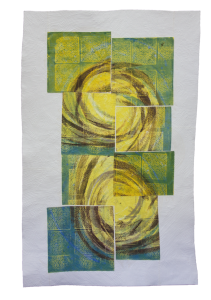
A week of color
Guess where I've spent the last week. Well, that's probably not a fair question. The sign will be both familiar and evocative to some, and won't register at all with others.
Mystery solved. Since last Sunday afternoon I've spent most of my waking hours at The Crow Timber Frame Barn in Baltimore, Ohio taking a special 6-day version of Carol Soderlund's "True Colors" workshop.
The workshop was great and, as usual, Carol and my fellow participants were inspiring. I'm on my way home tomorrow morning and ready to get back into the studio so I can apply some of what I've learned this week.
I haven't abandoned my independent study of MX dyes and their behavior, but this class has given me valuable direction that's going to save me lots of time and money. Thanks Carol! Another home run.
Wonderful show
I feel a little awkward saying this. Some little voice in my head is telling me that it's just not proper to be too proud, but... Dan and I just spent a wonderful 24 hours in Philadelphia roaming through the galleries that are part of Fiber Philadelphia. We saw so much wonderful work. I'm very proud to say that "Lines and Numbers", the show by the Art Cloth Network was among the best. I'm just thrilled with the way our show looks and I'm grateful to those who worked hard to organize, hang, and promote it. I feel like I'm riding on the coat tails of some talented and generous folks. Other highlights included the biennial show at the Snyderman-Works Gallery and the show at the Highwire Gallery (including new work by Rayna Gillman). Both are outstanding. I came away inspired.
Continuing workshop efforts
It's the end of Thursday and I'm pooped. I'm the last one in the studio, enjoying a little peace and the luxury of a working Internet connection. It's been a good week. Although I have nothing finished to show for it, I've got some new direction and about 5-6 pieces that, while they will require substantial work to finish, can be finished at some point in the future.
One piece in particular has been presenting an interesting challenge. I've been working from a practice watercolor in my sketchbook, trying to come close to the same look and feel on cloth.
Here's the sketchbook page. Love it.
The cloth. The image is too strong. It's not nearly this high-contrast or saturated in person
Here's the same cloth with an overlay of painted organza (the dark circle). I'm really happy with where this is going and I think I know what it needs next, but that's a project that requires more time, space, and concentration than I have right now. At least I know what comes next.
OK. Off to bed.
Getting intimate with MX colors
- I fully acknowledge that this might be a little crazy (in the OCD category).
- I'm only planning to dye the primaries, secondary, and tertiary colors, and I"m only dying a single value of each hue.
- Yes, there will be duplication from one color group to the next. For example, the same yellow will be crossed with multiple reds and blues.
- Produce a reference that shows how the primaries interact.
- Identify primary triads that speak to me and merit further exploration (Soderlund color cube?).
- Learn by doing.
- Develop color palettes different from the one that have become habitual to me.
Untitled work in progress

Getting ready for Kerr
Sunday morning I'm off to Bay St. Louis, Mississippi for a 1-week workshop with Kerr Grabowski. It's a very small group, just 6 of us, and all former students of hers. It should be great. Friends ask me what these workshops are like. Well, there's just no one-size-fits-all answer. Some are incredibly hard work. Others are lot's of laughing (and really hard work). It depends on the mix of teacher, students, and the phase of the moon. In every case there is learning and growth.
Now, Kerr is a special person. She's given me some of the most helpful critique I've ever received. And we laugh. It's hard to put a value on that. This YouTube video might give you a little insight into what her workshops are like. It's lots of what-if and "Oh, now I like that." There's lots of discovery and a good bit of laughter.
I'm talking myself into a big smile and a real sense of anticipation.
Restructured Circles #3
I finished this piece about a month ago and submitted it for a local show. No luck. It would have been nice to show it, but for some reason I'm not terribly disappointed that I don't have delivery, pickup, and reception on my to do list. Go figure. This is the 3rd completed piece in my "Restructured Circles" art quilt series. The marks are made entirely by discharge and I very happy with the results. The piecing is minimal, by which I mean it's 2 pieces. It doesn't get much more minimal.
When I finished the piece I stood back and said, "OMG it's a cairn." I've been taking pictures of rocks for years, and in the last few years have really become fascinated with stacked rocks. I think this might be the beginning of something. A new direction or a course refinement? To be determined.
All set for the Greenbelt Art+Craft fair
Sherill and I are all setup for the Greenbelt Festival of Lights Art + Craft Fair. For a first attempt booth I'm very pleased. As it worked out it's pretty much exactly a 50/50 mix of her work and mine. The framed work on the wall is Sherill's cut paper--just fantastic stuff. She's also got books and other paper work. She also make small purses and other things out of some my hand dyed and printed cloth from my scrap pile. I'll have to post some more detailed pictures of them. I wasn't sure what to expect, but they are terrific and absolutely cool. For my part is just miles of scarves--miles. I've very happy with the result of my recent work and I'm hoping for a good show.
Now I just need a drink, a little snack, and someplace to park my rear for a little while before bed. It'll be an early start tomorrow.
Finally finished: Part 4
OK. This is the last of the series of finally completed work, but I promise that there's more to come. These two pieces are called, "Sedona #1" and "Sedona #2". They're the first installments in a little mini-series inspired by a few days spent hiking in Sedona, Arizona earlier this summer. They each measure 30" w X 72" h. They're art cloth (cotton broadcloth) with a rod pocket at the top. They incorporate painting with thickened dye, low water immersion dyeing, soy wax resist, bound and stitched resist, and discharge with both chlorine and thiox.
Finally finished: Part 3
But wait, there's more. This one is called "Restructured Circles #2," which of course means it's another member of my "Restructured Circles" series. I have to say that I really love this piece. It's not heavily pieces, but it didn't need to be. It started out, as all of the pieces in this series will, as a whole cloth. It was then cut up and reassembled. In this case nothing happened to it after the reassembly other than quilting. The quilting is closely spaced echos following the general shape of the circular forms.
I'm pleased with the line quality and the feeling of the brush strokes, some of which I applied directly to the cloth and others indirectly through a silk screen. I also got where I wanted to be in terms of value and balance.
Finally finished: Part 2
This is the next installment in the series of recently finished work. It's called "Restructured Circles #1." I'm not sure that's the most evocative name, but it's part of a series by that name. I'm happy with both the concept and the result, and I'm looking forward to continuing this series for awhile.
The quilting is equally spaced parallel lines with a few lines intersecting at obtuse angles in the lower left. I used a mixture of variegated and light solid colored thread to create a visual variation in the quilting.
Finally finished: Part 1
This is the first of several posts showing newly finished work. This one is called "Line and Rhythm." I finished the quilt top probably two years ago, but have only recently completed the quilting. Like several recent pieces, the quilting here is very dense, about 1/4" spacing. I love the texture it creates.
I like this piece very much and have yet to make anything quite like it. I hope to get back to this sometime to use it as a starting point for a series. Actually, I can say that about several of pieces. Getting them photographed and getting some distance is allowing me to to see better what's working and what's not and to think about how individual pieces can inspire future work. Yes, of course, I know that I'm supposed to do that along the way--and I do take photos of work in progress. But, sometimes it seems that only at the very end--and sometimes only ofter considerable time has past--can I see the connection between one piece and something to follow.
UPDATED 9/21: In response to Judy's request, here's a detail shot of as well. Forgive the color balance and quality. It's an iPhone quickie.
By the time that I quilted this piece I'd switched to Aurifil 50 weight Mako cotton thread for quilting and I just love it. I was using Gutermann before. It's not bad thread per se, but the Aurifil is just so very superior. It's wonderfully fine. It feeds beautifully through the machine and there's virtually no lint (except of course from the batting). There's no local source around here that I know of so I've been mail ordering from Red Rock Threads in Nevada (redrockrockthreads.com).
Dyeing to Discharge: Workshop samples
Clamped resist on white fabric dyed black.
